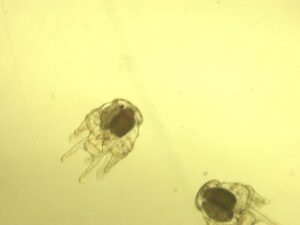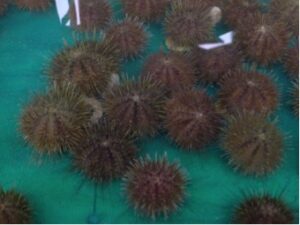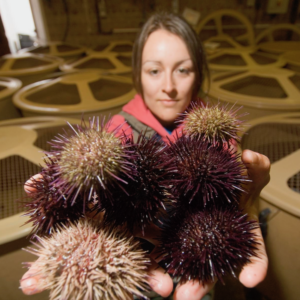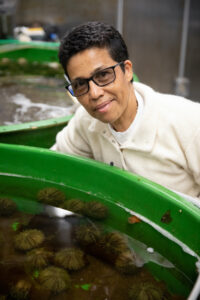Sea Urchin Hatchery Seed Project

We’ve been growing sea urchin seed in our custom hatchery since 2009 to produce juvenile sea urchins for industry and research projects. When things go well, we can grow thousands of seed to about the size of a dime in less than eight months. The diameter of a dime is almost 18mm and research shows that the best seed size for transplanting and trials is between 15-20mm diameter.
Our best year was 2009, when we produced over 40,000 seed for sea ranching and tank trials. However, hatchery production doesn’t always go as well as we would like and since 2009, we’ve had highly variable results…good one year, poor the next. This makes it difficult to promise potential sea urchin farmers a reliable supply of low-cost seed year in and year out.

Reliable and low-cost seedstock production is key to profitable sea urchin aquaculture, and there are many in the Northeast who would like to see this succeed. We know from other places, such as Japan, China, and Chile, that it is indeed possible to grow hundreds of thousands of sea urchin seed in a predictable and somewhat cost-effective fashion. The challenge lies in adapting their methods, which were developed for different sea urchin species, in different parts of the world, and at very large scale, to our species, region, and much smaller production scale. Anyone who has studied business or economics is familiar with economies of scale. In general, as production scale increases efficiency improves and unit costs go down. An additional challenge we face here in Maine is that in many countries sea urchin hatcheries are government subsidized, whereas here in the US we need to show that our hatchery can be supported by industry.
With all that as background, we are pleased to have recently received funding from the Northeastern Regional Aquaculture Center (NRAC) for a two year project to improve our hatchery production, provide seed at no cost to growers, and inform the industry at large about sea urchin aquaculture. The project is titled “Expanding green sea urchin production by removing key aquaculture challenges”, and it’s led by Dr. Coleen Suckling, our collaborator at the University of Rhode Island. Dr. Suckling comes to URI from the UK, where she led several sea urchin research projects.


In Maine, the project will be led by Steve Eddy, CCAR Director; Luz Kogson, CCAR Biologist; and Dana Morse of Maine Sea Grant. Luz has overseen CCAR’s sea urchin hatchery since 2016 and she is fast becoming one of the Northeast’s leading sea urchin hatchery experts. Dana will oversee education and outreach for the project, and he will work with extension agents in other Northeastern states to help sea urchin aquaculture expand and grow both within and outside of Maine.
We are especially excited that the project enables us to offer sea urchin seedstock at no cost to new growers. We already have several growers on board and we’re looking to sign up more. We believe sea urchins are a natural fit with kelp aquaculture (their favorite food!) and oyster farms. If you’re interested, please contact Luz by email at luz.kogson@maine.edu to get on the list for seed and to receive project updates.
Check out this Zoom event recording that highlights the new project on urchin culture; a collaboration between University of Rhode Island, University of Maine, and University of New Hampshire. Speakers reviewed the biology, production, market and economics of urchin culture, followed by a helpful discussion with attendees.
